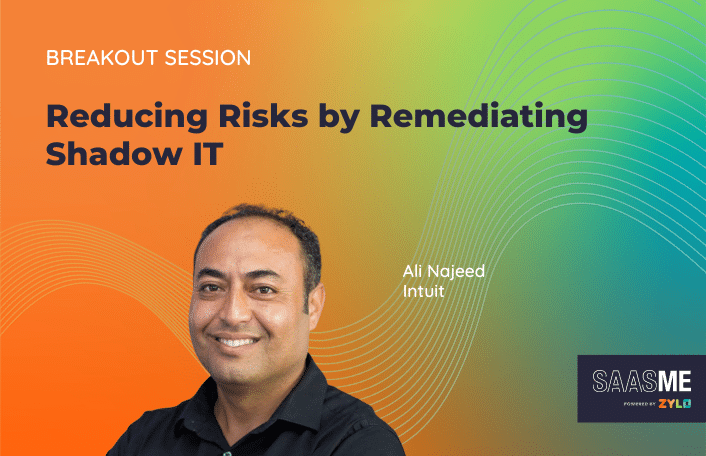07/25/2023
Table of Contents
Shadow IT refers to the proliferation and use of IT systems, software, and applications without the definite knowledge of the IT department. With the explosion of SaaS applications in recent years, shadow IT has become increasingly prevalent in companies, as any employee can get a SaaS license without going through IT.
On average, shadow IT represents 6% of SaaS spend, but 37% of application quantity. These unknown and ungoverned SaaS applications pose a risk to security, compliance, and your budget! We want to share some of Ali’s best tips for bringing shadow IT into the light and reducing associated risks.
The team at Intuit knows this challenge all too well. At SaaSMe 2023, Ali Najeed, the principal business system analyst at Intuit, discussed how he and the software management team reduced risks by remediating shadow IT.
Najeed had plenty of insightful recommendations and tips for SaaS management, but three points he made stuck out as universally useful to companies with SaaS applications—and potential shadow IT problems.
To start, Najeed and the software management team at Intuit onboarded their SaaS programs onto Zylo’s SaaS management platform. This allowed them the technology and data to implement the three changes below.
Understand Your SaaS Footprint
If the main challenge faced by Intuit was a lack of SaaS visibility, then the first task for Najeed and the software management team was to contextualize Intuit’s SaaS library and understand its SaaS footprint. They needed to see exactly what the footprint was, how people were purchasing SaaS applications, and what software was being purchased. They enabled accounts payable (AP) and expense data, integrated it with Zylo, and were able to look at the information they needed.
When they first delved into this task, they quickly realized that there was a lot of software being purchased through credit cards in business units and teams despite the company having enterprise agreements in place. From there, they started working with business units to help them understand what SaaS applications the company already had. Alongside this, they worked with the sourcing and procurement teams to establish some baseline policies around SaaS management and purchasing.
This first task enabled them to begin pulling back the veil of invisibility that SaaS applications had at Intuit. This did not solve every problem, but it gave them a foundation of communication and governance that allowed them to start reeling in some of the expenses that were being made through P-Card purchases.
This growing visibility was game-changing. Najeed explained, “It also gives us the ability to work with the business units themselves to start onboarding their lifecycle asset management into Zylo and additional tools that we have around software asset management.”
Create An Ongoing SaaS Management Framework
The initial step of understanding Intuit’s SaaS footprint and integrating it with Zylo gave a great foundation. But, Najeed and his team also understood that they couldn’t have a rigid, unchanging framework for SaaS management. They emphasized an ongoing development process for their management framework because this would allow them to face any challenge as it arose.
They began by optimizing the SaaS environment, reducing the duplication of different technologies purchased by different business units, and controlling the usage of different products by showing data that proves certain licenses are going unused (so-called “shelfware”) despite potentially being useful.
They went all-in working with business units to ensure they were aligned with the processes Najeed and the team were implementing. They work bilaterally with these teams to ensure that their needs are being met but redundant spending and shadow IT is still mitigated. This evolving framework has allowed Intuit to reduce its footprint in terms of expenses.
Najeed emphasized, “To-date, we are less than 1% of our total SaaS spent as being expensed being purchased through P-Cards, which is awesome compared to where we were before we had this visibility available to us.”
But, the development of their SaaS framework is still evolving. Najeed explained that they are still working on a few things. For one, they’re sharing all the data they have on different software products with the actual business unit product owners. Owners then have real-time information about who’s using what.
They’ve also integrated their Workday data into the Zylo platform. This lets them see what employees use what applications, and see when applications need to be cut if employees leave the company. This visibility allows business units to act on optimization opportunities themselves.
Leverage a Centralized SaaS Management Platform
The biggest change that has allowed them to make such big steps toward minimizing shadow IT is how they onboarded the entire company’s SaaS processes onto a single, universal platform: Zylo. As mentioned in both earlier takeaways, Najeed and his team use Zylo constantly to achieve visibility into Intuit’s SaaS footprint and establish a culture of optimization and universalism.
The team is still integrating Zylo even further and having great results. Najeed said, “Another area that we’re starting to focus on is using application catalog within Zylo. So that way, the business units, before even going out to purchase new software, they can come in and see exactly all the available software for them that the company has agreements with.”
An app catalog will allow Intuit to keep an efficient SaaS library and reduce products that fill the same functionalities, thus reducing redundant software purchases.
This management software enables Najeed and his team to continue streamlining Intuit’s SaaS processes in the constant fight against shadow IT and tech redundancies.
Final Thoughts
Najeed and his team have done an amazing job streamlining Intuit’s SaaS footprint. A huge factor of their progress and success was achieved by learning how to utilize Zylo’s software management platform to its full potential.
If you want to watch the breakout session yourself, you can find it on-demand here.

